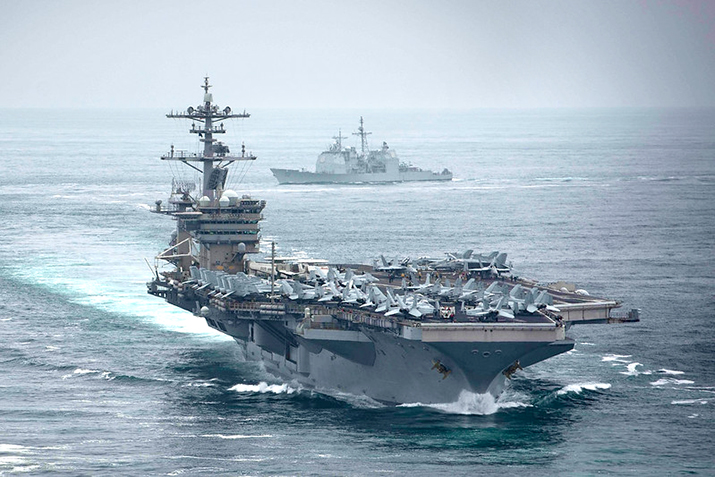Hanoi’s decision to host the visit of the USS Theodore Roosevelt underscores its determination to pursue better relations with the US


Le Hong Hiep
6 March 2020
Without much fanfare, the Nimitz-class USS Theodore Roosevelt has become the second American aircraft carrier to visit Vietnam after the Vietnam War, docking in Da Nang from 5 to 9 March 2020. When the USS Carl Vinson made the historic first visit to the same port in March 2018, it was a high-profile event, with the two sides openly discussing the port call during President Trump’s visit to Vietnam in November 2017. This time, the port call by the USS Theodore Roosevelt was hardly publicised. In fact, news of the visit was not released until only a few days before the visit.
The rationale for the low-key visit is not hard to divine. Vietnam is concerned that shining the spotlight on the event will unnecessarily provoke China. As the day for the visit drew nearer in late February, Vietnamese officials were still concerned about possible Chinese reactions to the visit. In the end, however, the visit proceeded as planned, to the relief of supporters of US-Vietnam relations. A cancellation would have put a brake on the momentum of bilateral ties and affected both countries’ regional strategic postures.
For America, a cancellation of the visit would have sent out a negative signal about its efforts to mobilise international support for its Indo-Pacific strategy, and undercut its military presence in the region. As the Philippines has recently terminated the Visiting Forces Agreement with the United States, the cancellation of the USS Theodore Roosevelt’s visit to Vietnam will further reinforce the perception that America is losing the strategic ground to China in the region.
For Vietnam, caving in to China’s pressures would expose Hanoi’s weaknesses and encourage Beijing to be more assertive in the South China Sea. Beijing will also be tempted to force Hanoi into further concessions. At the same time, cancelling the visit would have damaged the growing mutual trust between Vietnam and the United States, and cause Washington to question Hanoi’s sincerity in pursuing better relations. If the US decides to turn its attention away from Vietnam, Hanoi will face greater challenges in restoring the momentum of bilateral relations, and its bargaining position in the South China Sea vis-à-vis China will be affected.
For the aforesaid reasons, allowing the visit to proceed was the best choice for Vietnam. On the one hand, the visit will testify to Vietnam’s strategic autonomy and its ability to conduct diplomacy in an assured manner. This will command trust from partners and respect from rivals. On the other hand, it will send out consistent messages to both the United States and China.
Vietnam is likely to host future visits by US aircraft carriers as a symbolic component of bilateral defence cooperation
To the Americans, the message will be that Hanoi consistently attaches great importance to bilateral relations, and that Vietnam is serious in developing long-term strategic ties with the United States. It is also of no coincidence that the visit marks the 25th anniversary of Hanoi-Washington relations. To the Chinese, the visit signifies Hanoi’s determination to stand its ground in the South China Sea. If China continues to assert its claims in a forceful manner that disregards Vietnam’s interests, Vietnam is prepared to take firmer actions even if this comes at the expense of its long-term relationship with China.
That said, the intensification of Sino-American strategic competition and the lingering uncertainties about the Trump administration’s strategic commitments to the region have given Vietnam good ground to keep the visit low-key. The outbreak of Covid-19 has also provided Vietnamese officials with a convenient reason to persuade their American counterparts to proceed with the visit in a low-key manner.
Looking forward, Vietnam is likely to host future visits by US aircraft carriers as a symbolic component of bilateral defence cooperation. Given the symbolic nature of such visits, China will have little reason to react strongly. However, Vietnam should expect more maritime harassments and encroachments from China as it did last year, when China repeatedly sent a surveying vessel and accompanying ships to conduct illegal exploration activities in Vietnamese waters from July to October.
Part of China’s conventional strategic wisdom is based on an old saying: “bullying the weak and fearing the strong” (欺软怕硬). The history of Chinese diplomacy shows that Chinese leaders are masters of this principle. Should Vietnam appear to be weak and fearful of Chinese pressures, its loss in the South China Sea will become a self-fulfilling prophecy.
Le Hong Hiep is a Fellow at the ISEAS – Yusof Ishak Institute.
ISEAS Commentary – 2020/25
The facts and views expressed are solely that of the author/authors and do not necessarily reflect that of ISEAS – Yusof Ishak Institute. No part of this publication may be reproduced in any form without permission.


